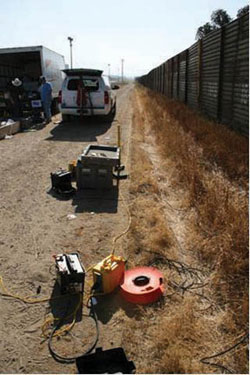ALBUQUERQUE, N.M. — You’d think it would be easy to use seismic waves to find tunnels dug by smugglers of drugs, weapons or people.
You’d be wrong.
Nedra Bonal of Sandia’s geophysics and atmospheric sciences organization is nearing the end of a two-year study, “Improving Shallow Tunnel Detection From Surface Seismic Methods,” aimed at getting a better look at the ground around tunnels and learning why seismic data finds some tunnels but not others.
Her eventual goal is to come up with a seismic detection process for the border and other areas where tunnels pose a security threat. Bonal’s project is funded by Sandia’s Early Career Laboratory Directed Research and Development program.
Most tunnels are found by tips from people rather than by scientific methods, Bonal said.
“It would be great if we could use this to do a better job with tunnel detection, so you could scan an area and know if there is or is not a tunnel and find it and stop it,” she said.
If researchers discover what it takes to pinpoint tunnels, the next step would be to develop streamlined seismic methods that would be more practical for the Border Patrol and military.
The study arose from earlier work at Sandia detecting shallow tunnels. Bonal said she was surprised when standard refraction and reflection processing techniques Sandia used could not successfully pinpoint some tunnels.
Researchers speculate the difficulty might be what’s called a halo effect around a tunnel, in which fracturing and other geological anomalies create diffuse boundaries and hide the tunnel. The earlier, broader research produced several successes in tunnel detection, but was not focused specifically on what happens in the area where tunnel and earth meet, which might help explain why tunnels can be detected in some cases but not others.
Bonal is looking at whether seismic waves are strongly impacted by fracturing or saturation of pores in rock or soil, as well as varying pressures at different depths. Physical processes change from shallow depths to deeper depths, but it isn’t clear just where that change occurs, she said.
In addition, the halo effect is both asymmetrical and complex.
“It depends on the geology or the soil as well as the seasonal variation, rain events and the relation to the water table,” Bonal said. “So it’s a pretty complex regime just from the hydrology standpoint.”
More research is needed, but asymmetry may turn out to be an advantage because an asymmetric area might show up better than a symmetrical one, she said. “These anomalous areas are what we may identify as tunnels in the data,” she said.
Bonal began her project by figuring out what gaps existed in current scientific knowledge, then modeling real-world scenarios based on collected data that would affect hydrology models and in turn, seismic waves: an area’s soil and other geology, the depth of rock fracturing around a tunnel in a particular environment, the probable tunnel size, its relation to the water table and seasonal variations in that relationship.
“We try to get some bounds to this problem,” she said. “If we can’t see it in the best-case scenario, then there’s really no point in trying to see it in more subtle factors that may affect the seismic waves.”
The team ran the hydrology models to get some results, then converted those results into seismic velocities that could be plugged into Sandia’s 3-D elastic seismic wave propagation simulation code, Bonal said. These results will produce synthetic seismograms that will be compared to field data from the real environment and can be used to develop other processing techniques. That will in turn produce data that’s expected to look like what’s collected in the field.
“We can then compare the effects of a tunnel versus no tunnel and changes in fracturing and saturation of the tunnel halo versus no changes to assess their impact on seismic waves,” she said.
The standard used to show the relationship of saturation in pores in rock or earth to seismic velocities is an oil industry standard called the Biot-Gassmann theory. However, few experiments have tested that theory at shallow depths where border tunnels are commonly dug, Bonal said.
“The few that have been done have shown that the Biot-Gassmann theory tends to overestimate the velocities for those unconsolidated near-surface materials where the pressures perhaps aren’t as great” as at depths where the oil industry operates, she said.
The very near surface behaves one way, but at some point behaviors change because of greater pressures and other factors, she said. The Biot-Gassmann theory holds well at greater depths where pressure is more intense and the rock is more consolidated, while another theory, Brutsaert, describes what happens very close to the surface.
“But there’s sort of a middle regime where I’m looking where I’m not real sure either one of them works as well as they need to,” Bonal said. She expects to have the modeled data results soon to compare with seismic data collected from previous experiments to help resolve the issue.
Experimentally verifying at what depth or in what materials competing theories work best lies outside the scope of her LDRD, but Bonal hopes to work on those puzzles in a future project. “I think there are still plenty of questions we have that need to be answered but I am very excited about the progress made so far. I have been able to detect a tunnel that I previously had not seen by other analyses,” she said.
For more information, click here.

